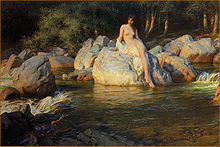- Kelpie
-
This article is about the aquatic creature from Celtic mythology. For the Australian dog breed, see Australian Kelpie.
Kelpie 
The Kelpie by Herbert James DraperMythology Celtic mythology Grouping Mythological Sub-grouping Ancient folklore Country Scotland
IrelandHabitat Rivers
LochsSimilar creatures Each uisge
NixThe kelpie is a supernatural water horse from Celtic folklore that is believed to haunt the rivers and lochs of Scotland and Ireland; the name may be from Scottish Gaelic cailpeach or colpach "heifer, colt".[1]
Contents
Description and behaviour
The horse's appearance is strong, powerful, and breathtaking. Its hide was supposed to be black (though in some stories it was white), and will appear to be a lost pony, but can be identified by its constantly dripping mane. Its skin is like that of a seal, smooth but is as cold as death when touched. Water horses are known to transform into beautiful women to lure men into their traps. It is understood that the nostril of the horse is what creates the illusion of grandeur. The water horse creates illusions to keep itself hidden, keeping only its eye above water to scout the surface, much like the illusion of a fish's pupil. It is wise to keep away from them.
The fable of the kelpie differs depending on the region where it is told. Other versions of the story describe the kelpie as "green as glass with a black mane and tail that curves over its back like a wheel" or that, even in human form, they are always dripping wet and/or have water weeds in their hair.
The water horse is a common form of the kelpie, said to lure humans, especially children, into the water to drown and eat them. It performs this act by encouraging children to ride on its back. Once its victims fall into its trap, the kelpie's skin becomes adhesive and it bears them into the river, dragging them to the bottom of the water and devouring them—except the heart or liver. A common Scottish tale is the story of nine children lured onto a kelpie's back, while a tenth keeps his distance. The kelpie chases him and tries to catch him, but he escapes. A variation on this is that the tenth child simply strokes the kelpie's nose but, when his hand becomes stuck to it, he takes a knife from his pocket and cuts his own hand off and cauterizes it with wood from a near by fire. He saves himself but is unable to help his friends as they are pulled underwater with the kelpie.
Similar creatures
 Boy on White Horse by Theodor Kittelsen
Boy on White Horse by Theodor Kittelsen
In Orkney a similar creature was called the nuggle, and in Shetland a similar creature was called the shoopiltee, the njogel, or the tangi. On the Isle of Man it is known as the cabbyl-ushtey (Manx Gaelic for "water horse", compare to Irish capall uisge) or the glashtin. In Wales, a similar creature is known as the Ceffyl Dŵr. It also appears in Scandinavian folklore where in Sweden it is known by the name Bäckahästen, the brook horse. In Norway it is called nøkken, where the horse shape is often used, but is not its true form. In the Faroe Islands it is called Nykur and in Iceland it is called nykur or nennir. Another similar Scottish water horse is the each uisge, which also appears in Ireland.
See also
References
- ^ Merriam-Webster's Collegiate Dictionary, 11th ed., p. 683.
Sources
- Sjögren, Bengt, Berömda vidunder, Settern, 1980, ISBN 91-7586-023-6 (Swedish)
External links
- Kelpie
- Portal of Transformation: Kelpie
- Kelpie (Mysterious Britain & Ireland)
- The Kelpie of Loch Garve (Folktales - Mysterious Britain & Ireland
Celtic mythology series Characters in Scottish mythology and folkloreBean Nighe • Bean-shìdh • Beira • Cailleach • Ceasg • Crom Dubh • Deò-ghrèine • Each uisge • Glaistig • Kelpie • Niseag • Ossian • Scota • SeonaidhCategories:- Celtic legendary creatures
- Scottish folklore
- Shapeshifting
- Fairies
- Mythological horses
- Water spirits
Wikimedia Foundation. 2010.
